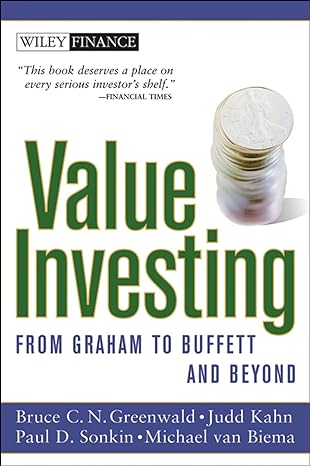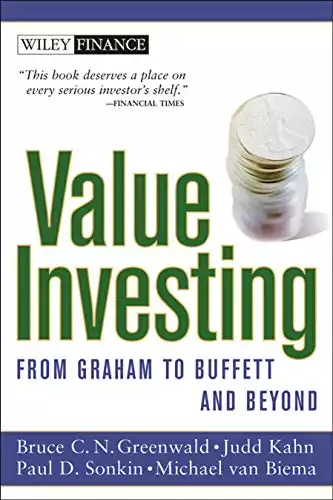Overview : Value Investing Book By Bruce Greenwald
-
Book Title: Value Investing: From Graham to Buffett and Beyond
-
Author: Bruce Greenwald, Judd Kahn, Paul Sonkin, Michael van Biema
-
Publication Date: October 2001
-
Rating: 4.5
-
price: $26.99
-
Pages: 300
About the Author
Bruce C. Greenwald is a renowned economist, professor, and author, widely recognized as an expert in value investing. He served as a professor at Columbia Business School, where he taught and mentored many finance professionals. Greenwald authored influential books, including Value Investing: From Graham to Buffett, emphasizing disciplined, research-driven investment strategies.
Lets see book review of value investing by Bruce Greenwald
Introduction to Value Investing by Bruce C. Greenwald
In the ever-evolving world of finance and investing, Bruce C. Greenwald's "Value Investing: From Graham to Buffett and Beyond" stands as a beacon for those seeking to master the art of value investing. This comprehensive guide not only pays homage to the foundational ideas set forth by Benjamin Graham but also extends the conversation to include insights from modern investing legends, providing a bridge between classic principles and contemporary market realities.
Value Investing Book Summary
Greenwald's work is a masterful blend of theory and practice, offering readers a deep dive into the core principles of value investing while simultaneously providing practical tools for application in today's complex financial landscape.
Key Themes and Concepts:
- Revisiting Graham's fundamental principles
- Introduction of the "Earnings Power Value" (EPV) framework
- Analysis of Warren Buffett's evolved investment strategy
- Exploration of other influential value investors' approaches
- Practical case studies and real-world applications
Analysis of Themes: Bridging Past and Present
Greenwald expertly navigates the evolution of value investing, from Graham's emphasis on quantitative analysis to Buffett's focus on qualitative factors like competitive advantage. The book's strength lies in its ability to synthesize these approaches, offering a comprehensive framework for modern value investing.
"The goal of value investing is simple: to buy securities that are trading for less than their intrinsic value."
This core principle is expanded upon throughout the book, with Greenwald introducing innovative concepts like the EPV model, which provides a more nuanced approach to assessing a company's worth in today's market conditions.
Writing Style: Academic Rigor Meets Practical Insight
Greenwald's writing style is characterized by its academic depth and analytical precision. While this may present a challenge for novice investors, it offers a wealth of knowledge for those willing to delve deep into the intricacies of value investing.
Strengths and Weaknesses of Value Investing Book
Strengths:
- Comprehensive coverage of value investing principles
- Introduction of innovative valuation techniques
- Rich with case studies and practical examples
- Insights from multiple investing legends
Weaknesses:
- May be challenging for beginners due to its academic tone
- Some concepts may seem less applicable in high-frequency trading environments
Value Investing Related Books
While Benjamin Graham's "The Intelligent Investor" remains the seminal work on value investing, Greenwald's book offers a more contemporary perspective. Compared to works like Joel Greenblatt's "The Little Book That Beats the Market," Greenwald's approach is more comprehensive and academically rigorous.
Relevance to Current Market Trends
In an era of cryptocurrencies and algorithmic trading, Greenwald's emphasis on fundamental analysis and long-term value might seem contrarian. However, recent market volatility has reinforced the importance of understanding intrinsic value, making this book particularly relevant for investors seeking stability in uncertain times.
Highlights from Value Investing: From Graham to Buffett and Beyond by Bruce C. Greenwald
Core Principles of Value Investing: Focus on buying undervalued stocks with a margin of safety to minimize risk.
Benjamin Graham's Legacy: Emphasizes disciplined investment strategies, prioritizing intrinsic value over market trends.
Warren Buffett’s Approach: Invest in companies with strong competitive advantages and excellent management.
Margin of Safety: A key concept to protect against errors in valuation or unforeseen market changes.
Understanding Business Economics: Analyze a company’s financials, industry position, and long-term prospects.
Patience and Discipline: Success in value investing requires a long-term perspective and the ability to ignore market volatility.
Valuation Techniques: Learn different methods to assess a company's true worth.
Conclusion: An Essential Resource for Serious Investors
"Value Investing: From Graham to Buffett and Beyond" is an indispensable resource for anyone serious about mastering value investing. While it may require dedication to fully appreciate, the insights gained are invaluable for navigating today's complex financial markets. For those looking to refine their investment strategy or gain a deeper understanding of value investing principles, this book provides the tools and knowledge needed to succeed in the ever-evolving landscape of personal finance and investing.
Final Thoughts:
- Ideal for intermediate to advanced investors
- Offers a comprehensive framework for modern value investing
- Encourages a disciplined, long-term approach to wealth building
Ready to elevate your investing game?
Purchase "Value Investing: From Graham to Buffett and Beyond" here and start your journey towards becoming a more informed and successful investor today! In conclusion, this article has provided an overview of the topic at hand.





